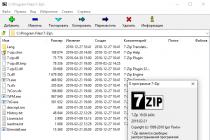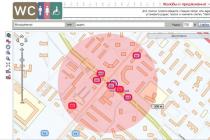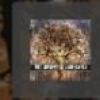The ancient Basilica of San Zeno Maggiore has gone through a lot of destruction in its history and has risen from the ruins many times. The first church on this site appeared in the 5th century at the direction of King Theodoric, who ordered the erection of a chapel over the grave of Bishop Zeno of Verona. This saint (by the way, a native of North Africa) was already very revered c. One of the ancient manuscripts even mentions the following miracle: when the city was flooded during a flood, the water allegedly stopped right in front of the threshold of his church.
In the 9th century, the old basilica was destroyed and a new church was built in its place - also specifically for the relics of St. Zeno. It stood for about a century, and after that it was practically razed to the ground during the war with the Hungarians. During the period when the preserved crypt of the church was undergoing restoration, the relics were kept in the cathedral, and then they were returned to their place.

Finally, in 967, the Basilica of San Zeno Maggiore was completely rebuilt again. In a modern building, we can observe individual elements of the construction of those years, because later the temple was still rebuilt after the earthquake of 1117, expanded and rebuilt. In the 11th century, a bell tower was erected here, and in the 13th century, a Benedictine monastery was built next to the basilica.

Over time, the monastery ceased to exist, and by the 19th century the church itself was dilapidated and was forgotten by the parishioners. Its restoration, already as a historical monument, began only in 1993. Today it is not only a significant tourist attraction, but also a functioning temple.

How to get to the Basilica of San Zeno Maggiore
The Basilica of San Zeno Maggiore is located at Piazza San zeno that is on the left bank of the Adige River. This is a fairly lively area with good transport links, there are several well-known hotels and restaurants.
The exact address: Piazza San Zeno, 2, 37123 Verona, Italy
How to get there from Verona train station:
Option 1
On foot: 1.6 kilometers via Circonvallazione Oriani and Circonvallazione Maroncelli. Travel time will be about 20 minutes.
Option 2
Bus: take route 91 to stop P.za Corrubbio 6.
On foot: 200 meters. Follow Vicolo dietro Caserma Chiodo southwest towards Piazza Corrubbio. Turn right onto Via S. Procolo. The destination will be on the right.
Basilica of San Zeno Maggiore on the map
What to see
The Basilica of San Zeno Maggiore was built with three naves - the highest in the center and the lower side naves. It is made of golden-pink tuff, and the facade is decorated with a marble portal. Two tall columns framing the entrance rest on the figures of lions, and above you can see marble statues of two saints - John the Theologian and John the Baptist. Above the front door, the bishop himself is depicted, surrounded by soldiers and horsemen. Such a luxurious design was created by the Italian master Nicolo, who also worked on the decoration of the Cathedral of Verona.
In addition, on the facade of the basilica, you can see marble bas-reliefs with scenes from the Holy Scriptures, as well as scenes from some local legends. In short, before getting inside, visitors spend a lot of time looking at these artfully carved scenes and the original architecture of the temple. The largest element of the façade is the round window by the architect Brioloto. It was named "Wheel of Destiny" because of the six figures of people located in a circle - some of them depict joy, others in despair.
The window on the facade of the basilica is called the Wheel of Fate, and the figures around the window depict joy and despair
The gates of the Basilica of San Zeno Maggiore are no less interesting. Lined with 48 bronze plaques, they deserve special attention. On each tablet there is one of the Bible stories, and here you can also find scenes from the life of Zeno of Veronius.
What's interesting inside
Many tourists agree that the inside of the Basilica of San Zeno Maggiore looks much more spectacular than the outside. There is something to see here - a stately interior with columns, rich decoration, balustrades and marble statues.
In the presbytery, you can see an old fresco by the artist Altichiero with the image of the Virgin Mary, it dates back to 1397. There is also a 14th century cross and a 16th century triptych. The author of the latter was the famous Italian artist Andrea Mantegna. Interestingly, part of this triptych is currently kept in the Louvre. During Napoleon's invasion of Italy, he was taken out of Verona, and then returned back to the basilica, but without the lower panels (instead of them, you can see copies).

The presbytery is separated from the rest of the church by an elegant balustrade - a real work of art. It is decorated with statues of the 12 apostles headed by Jesus Christ, and a little further you can find a sculpture of St. Zeno, whose authorship is still unknown.

But the main value of the Basilica of San Zeno Maggiore is, of course, a transparent shrine with the relics of the patron saint of Verona. It is located in a dungeon - a church crypt, where visitors are allowed to go on a guided tour. In addition to tourists, many pilgrims come here every year.

Finally, another interesting place in the basilica is the covered gallery (cloister) adjacent to the main building. It houses several medieval tombstones, as well as a collection of antique inscriptions. And the walk itself along the double colonnade with arched openings will appeal even to those who are indifferent to ancient architecture.

Opening hours and ticket prices
The Basilica of San Zeno Maggiore is ready to welcome guests:
- March to October - 8:30 am to 6:00 pm.
On Sundays, it is available to tourists no earlier than 12:30, regardless of the time of year (in the morning mass is held in the church).
Look for up-to-date information at.

Excursions
Since the Basilica of San Zeno Maggiore is a functioning temple, it regularly hosts mass and organ sounds. For believers, admission is, of course, free. Tourists can come here for an excursion, the ticket price is 2.5 euros ( 2nd ~ 172 RUB )... Alternatively, you can purchase the Verona Card and visit this temple for free, along with other historic buildings and museums in Verona.

Together with the ticket, visitors are given an audio guide in Russian - they can learn the history of the church and its main attractions. The price also includes a visit to the dungeon to the relics of St. Zeno. Photographing is allowed almost everywhere. The duration of an audio guide lecture is about half an hour, but it is worth allocating at least an hour and a half for the excursion, because there is still a cozy patio where you just need to sit in silence, enjoying the atmosphere.

Panorama of the Basilica of San Zeno Maggiore in Verona
The Basilica of San Zeno Maggiore is an amazing place where time seems to stop, where you want to think about eternal values. When you decide to leave the temple, we recommend staying in Piazza San Zeno - on Sundays there is an antique market and you can buy original souvenirs. Then go to other interesting places in Verona - literally 10-15 minutes walk is the Arsenale Franz Josef I Museum and the ancient castle of Castelvecchio.
Business card
Address
Piazza San Zeno, 2, 37123 Verona VR, Italy
Official site
Working hours
November to February - from 10:00 to 17:00;
March to October - 8:30 am to 6:00 pm
Visits on Sundays are allowed no earlier than 12:30
Something is wrong?
Report inaccuracies
Design and architecture| ItalyThe Basilica of San Zeno Maggiore is one of the most beautiful Romanesque churches in Verona, built on the burial place of the patron saint of the city of Zinon of Verona, who was also the first local bishop. Saint Zenon died at the end of the 4th century, and several decades later a small church was built over his grave by the order of the Emperor Theodoric the Great. It existed for about four centuries, until it was destroyed in 807, and a new temple appeared in its place, in which the relics of Zinon were placed. This church stood even less - at the beginning of the 10th century, during the Hungarian invasion, it was almost completely destroyed, and the relics of the saint were transferred to Cathedral... From there, in 921, they were returned to the crypt - the only surviving structure of the church. The construction of the current building of the basilica was completed in the second half of the 10th century by decree of Emperor Otto the Great, and a bell tower was built in the 11th century. Despite the fact that the building was badly damaged during the earthquake of 1117, it was already restored by 1138. At the end of the 14th century, the next renovation work was carried out here - the roof was replaced, the plafond of the central nave was created and the apse in the Gothic style was added. Then on long time the temple turned out to be half-abandoned, and in the early 1800s was in a depressing state. Its complete restoration was completed only in 1993. The current building of the basilica is built of local volcanic tuff with rare marble intersperses, which are decorated with bas-reliefs on the theme of the Last Judgment. The author of these bas-reliefs, which today, unfortunately, are poorly distinguishable, is the sculptor Brioloto. He also created a round rosette window in the center of the facade, called the "Wheel of Fortune". The entrance to the church is decorated with a Gothic portal, created in the 12th century by the master Nicolo, who also worked on the portal of the Cathedral of Verona. The columns of the portico support the figures of lions, which are tearing apart the prey, and the portico itself is decorated with sculptures of John the Evangelist, John the Baptist and images of the 12 months of the year. Here you can also see the image of St. Zeno surrounded by foot and horse soldiers. On the sides of the main entrance in 4 tiers there are 16 bas-reliefs made on the subjects of the Old and New Testaments, as well as depicting medieval knightly scenes. The gates of the basilica are faced with bronze panels with biblical subjects, some of which are already about 900 years old! The interior of the temple is striking in its luxury: here you can see a 12th century baptismal font carved from a single piece of marble, a carved stone altar, 13-15th century frescoes and other works of art, including the famous triptych by Andrea Mantegna "Madonna enthroned with angels and saints" ... One of the naves contains a huge porphyry bowl, discovered during excavations of ancient Roman baths. And in the crypt, in a crystal reliquary, are the relics of St.Zinon. Next to the basilica there is a 12th century cloister, whose galleries consist of numerous double columns with arches. Here you can see several medieval tombstones, including
The Abbey of Saint Zeno was a whole monastery complex, which played a very important political role in the Middle Ages for Verona. The abbey complex included the abbot's palace, two towers, a church and cloisters. In the Middle Ages, a residential area grew up around the monastery, for which it served as a fortress. However, the abbey itself was destroyed during the time of Napoleon, and the Basilica of St. Zeno with a bell tower, which was built in the 12th century, several cloisters, a tower and the Church of St. Proclus have survived to this day.
Surviving to this day
San Zeno Maggiore is a fine example of Italian architecture, executed in the Romanesque style. In addition, a large collection of works of art from different eras is kept within the walls of the basilica. The building that can be seen today was built in the 10-11th centuries on the site of an ancient church. At the beginning of the 10th century, the relics of the saint were transferred to the crypt, which is located on the lower floor of the current basilica.
The façade of the temple makes a lasting impression with its powerful simplicity and beautiful Romanesque decoration. In the very center there is a huge rose, which is a symbol of the wheel of fortune. The six statues that adorn the rose itself convey all the ups and downs in a person's life and how quickly things can change.
The portico includes a tympanic arch that rests on columns. The base of the columns is decorated with two stone lions. At the very top of the pediment is the blessing hand of the Lord, and under the arch, on the lunette, Saint Zeno is depicted trampling the demon with his feet and blessing the people. On both sides of the portal there are 18 bas-reliefs created in the 12th century. Nowadays, the church portal is always closed in order to preserve the luxurious bronze doors, which are decorated with 24 reliefs of the 12th century, dedicated to the Old Testament.
Medieval grandeur
The interior of the church has three tiers: the presbytery, the central part and the crypt. The crypt, built in the 10th century, was rebuilt twice in the 13th and 15th centuries. It is a small church with nine naves separated by 49 columns decorated with carved capitals. The central part of the temple includes three naves, separated by powerful cruciform pilasters with composite capitals.
The church naves, as well as the Cathedral of Verona, contain a large collection of works of art dating back to the 12th and 14th centuries. Among them you can see a font made in the 13th century, a fresco depicting St. Christopher, the painting "Our Lady and the Saints" by Francesco Torbido and many others. Above the crypt is a presbytery, which rises strongly above the level of the nave. A sample of Renaissance painting is kept here - the polyptych of Saint Zeno, dating back to the 15th century. The lower part of the paintings was replaced with a copy, and today you can admire it in France.
Wheel of Fortune
This is one of the topics of religious content,
which during this period was repeatedly addressed
in various forms of art
In Verona, architectural monuments of the barbarian era have not survived, although numerous references to them in the Cathedral, in the churches of Santo Stefano, Santa Maria Antica, San Lorenzo and others suggest that this time was not a break in art.
Only with the establishment of the communal system in construction began a period worthy of comparison with the activities that gave life to Roman Verona. Already during the reign of Archdeacon Pacific, the Church of San Zeno was renewed, which was burned by the infidels before 806.
On May 21, 807, in the church, restored by the will of King Pepin and Bishop Rotald, the hermits Benigno and Caro, specially summoned from their desert on Baldo, above Malcesine, placed in the church the relics of Saint Bishop, the patron saint of Verona. In 900, the first monstrous Hungarian raid devastated the Church of San Zeno and everything that was in the vicinity of Verona. Only at the beginning of the 11th century, some time after the end of the agitating Hungarian invasions, when the people, to ensure their safety, realized the need to establish communes, began the formation of the Basilica of San Zeno in its modern form, together with the adjacent large Benedictine monastery. Compared to the ancient city, San Zeno is located in the suburbs, or rather, in the area of the largest necropolises of Roman Verona, stretching to Via Gallica, the road that connects Verona and Bresa.
The new building, which suffered serious damage during the 1117 earthquake, was almost completely completed in 1138. The high bell tower (72 m) was started in 1045 and completed in 1178. To the left of the facade rises the Abbey Tower, inside of which there is a fresco repeating the theme of the Wheel of Fortune.
This tower is the only monument left from a large and powerful Benedictine monastery, abolished in 1773 and destroyed for use as building material in 1810.
San Zeno. Facade.
The sculptures are signed by the two most
famous sculptors of the Romanesque style:
Nicolo and Guglielmo
The façade of San Zeno is a magnificent example of Padan Romanesque sculpture. On the semicircular strip surrounding the lunette, you can read the name of the sculptor Nicolo, the one who left his signature at the Cathedral in Ferrara. Already Simeoni stressed that the image of the lunette glorifies the formation of the Verona commune. In the center of it is St. Zeno holds the city flag and tramples the demon with his feet. In the strip under the lunette, some of the saint's miracles are presented. On the two architraves, on which the arch of the portico with two columns rests, groups of three figures symbolizing the months are depicted, repeating the theme widespread in Romanesque churches, aimed at changing the concept of labor, which appears before us not as a biblical curse, but as an instrument for the exaltation of man. ... On the side of the portico with two columns there are marble reliefs, on the right with episodes from the Old Testament, signed by the same sculptor Nicolo, while the reliefs on the left, depicting scenes from the life of Jesus, are signed with the name of Guglielmo. The lowest reliefs are distinguished by their secular themes: the hunting of King Theodoric on the right, two duel scenes on the left. This pictorial complex frames a bronze door decorated with forty-eight plates, of which only two are not made on religious subjects: these are plates with masks. The scenes on the left wing were mostly performed by a master of an earlier era, scenes on the right wing were performed later by the so-called Second Master. Four discs with the stories of St. Zeno in the lower part of the right wing. As you can see, we are not talking about a single work, the door was made in two stages - before and after the earthquake of 1117. Nearby reliefs with scenes "Original Sin" and "Kiss of Judas" make it possible to compare the art of two masters, Nicolo and Guglielmo. The first of them, whose style is more coarse and energetic, always offers rather large figures and owns the entire pictorial field, which brings his style closer to the art of Viligelmo, the great master of Romanesque Padan sculpture who worked in the cathedral in Modena.
The second, Guglielmo, is more flexible and expressive, does not give absolute superiority to the figures, and sometimes freely places them in a rugged architectural space. The secular scenes of the lower band, badly damaged, indicate that both main masters had assistants.
The interior of San Zeno is dominated by a spacious main nave crowned with a linear ceiling in the shape of a ship's keel. On the border with the third large aisle, the difference between the lower church and the upper church becomes noticeable.
In the spacious crypt, a real underground church, there is a shrine with the relics of the saint, revived by the confession of 1838. On the right side you can see the gravestone urn of three saints (Lucillia, Lupicin and Crescentian), a striking example of sculpture from the early 12th century. Climbing from the crypt to the church located above, we will consider on the gallery a number of statues depicting Christ and the apostles, the work of German masters of the early 13th century. The main altar contains a three-winged altarpiece of Mantegna, painted in the years 1457-1459, the first high message of Renaissance painting in Verona. In the small apse on the left there is a marble statue “Laughing St. Zeno ”, the image of the benevolent patron of the city, dating back to the beginning of the XIV century. Next to the door leading to the sacristy is the statue of St. Proclus, a work signed and dated by Giovanni Rigino (XIV century). Going down to the lower church again, behind the altar of the Addolorata (Sorrowful Mother of God), you can go to the door leading to the monastery courtyard, unique for its combination of small semicircular arches with lancet arches.
The Basilica of San Zeno Maggiore in Verona is famous for the relics of Saint Zenone da Verona. In its present form, the basilica was built in the 10th century according to all the canons of the Romanesque style.
The history of the Basilica of San Zeno Maggiore
At the burial site of Zeno of Verona, who was the first bishop of Verona, a small church was originally built. The work was carried out in the 5th century by order of Theodoric the Great.
Under King Pepin in the 9th century, it was decided to destroy the old church in order to erect a new building in its place. The remains of Saint Zeno were moved to the newly built church. However, this church also did not last long - in the 10th century, the building was badly damaged during the war with the Hungarians.
In the same 10th century, a modern Romanesque basilica was erected on the site of a dilapidated church. The new church for the most part withstood the earthquake of 1117 and by 1138 it was expanded and completely restored. In the 14th century, the roof of the building was replaced, and the Gothic apse and plafond of the central nave were created.
Not far from the basilica there is a detached tower, which was built in the 13th century. This is part of a monastery that was once located next to the church.
The architecture of the Basilica of San Zeno Maggiore
Outwardly, the basilica is not very remarkable: a restrained Romanesque style in gilded pink colors with a large window in the central part. But special attention should be paid to the central entrance with Gothic decorations and the interior decoration of the church. It is here that the famous triptych of Andrea Mantegna is located.
Photo: Kiev.Victor / Shutterstock.com
Facade
The Basilica of San Zeno Maggiore has three naves. Golden tuff from Verona was used for its construction. In the middle part of the basilica there are marble inserts depicting scenes from the Last Judgment. Their author is the sculptor Brioloto.
Central portal
Above the entrance you can see the Gothic portal, created in the 12th century by the master Nicolo. He also worked on the central entrance to the Cathedral of Verona.
At the base of the entrance columns there are sculptures of lions tearing up prey. On the portico there are figures of John the Baptist, John the Theologian and symbols of the 12 months of the year. And the lunette of the portal is decorated with the image of Saint Zeno, who is surrounded by soldiers.

On the sides of the portal there are 16 bas-reliefs telling about scenes from the Old and New Testaments.
Above the entrance, in the central part of the facade, there is a round rose-shaped window. It was created by the same Brioloto. Since the figures of 6 juggling characters are depicted around the circumference of the window, which either ascend upwards by fate, then fall downwards, this window is called the "Wheel of Fortune".
On the gates of the basilica there are 48 panels of the 12-13th centuries, belonging to German masters. They depict 4 miracles of Saint Zeno and scenes from the Bible.
Interior decoration
Inside the basilica, there are two massive columns that support the vault of the church. The main nave rests on two semicircular arches. Two wide staircases lead to the crypt.

The basilica has a 12th century baptismal font made of solid Verona marble. Also of artistic value are two bowls and a carved altar with columns, at the base of which there are figures of a lion, a bull and a snake, symbolizing the evangelists.
On the right is the Baroque altar of the Sorrowful Madonna. Also noteworthy is the wide porphyry bowl from Roman baths.
And most importantly, the basilica contains a crystal reliquary with the relics of St. Zeno, which were found in a church that was previously located on this site.
Frescoes
A large number of frescoes from the 13th-14th centuries adorn the walls of the basilica. These are images of the White Madonna, St. Christopher, the Crucifixion of Christ, Baptism, Saints George and Stephen. There is also the famous fresco "Madonna Enthroned with Saints" by Altichiero in 1397 and the triptych "Madonna Enthroned with Angels and Saints" by Andrea Mantegna.
On the balustrade stands out the statue of Christ surrounded by 12 apostles. The statue of Saint Zeno can be seen in the small apse on the left.
The cloister
The cloister was added to the basilica in the 12th century. Throughout the gallery, there are double columns connected by arches. One of the pavilions houses a statue of John Paul II. Among the medieval tombstones kept in the cloister, the tombstone of the Scaliger family from 1313 occupies a special place. A collection of inscriptions from ancient times is kept in the lapidarium next to the cloister.













